Sifang Art Museum: Possible Worlds
“The Garden of Diversion”: Sifang Art Museum Inaugural Exhibition
Sifang Art Museum (No.9 Zhenqi Road, Pukou District, Nanjing, Jiangsu, China) Nov 2–Mar 2, 2014
Someone seeking a backdrop for a present-day science fiction fable might find one in the Pearl Spring park outside Nanjing. Buses carrying guests invited to the official opening of Sifang Art Museum on Saturday ascended an already pock-marked road up a hill lined with autumnal trees and past a barracks of hefty—but empty—Baroque-style villas, their waiting pleasure domes conspicuous against a white sky. Over the brow of the hill, the atmosphere, heavy with pollution and coming rain, settled around the enclave of buildings with the museum at its apex. The lights from the gallery space glowed yellow from inside the structure, looking strange and spectacular on a grassy slope backed by thick trees.
Sifang Art Museum and the buildings surrounding it on this large scenic site are the pet project of real estate developer Lu Jun and his son Lu Xun, who have personally initiated and funded it to the tune of some USD$164 million. The circa 20,000-square-foot museum was designed by Steven Holl Architects; their statement calls it “the Gateway to the Contemporary International Practical Exhibition of Architecture,” by which is meant the other buildings conceived by prominent names in the field, including David Adjaye and Alberto Kalach. In total, there are 20 structures—finished and unfinished—including the museum and a conference center by Arata Isozaki.
The design for the museum is based on the concepts of traditional Chinese painting—for example, alternating space. Its pale, square tubular structure is supported seemingly by a single stem from which a G-shaped plan flattens out and unfurls at right angles in a clockwise direction, culminating in a wide window opening overlooking the park. The high cantilevered form of the building delivers itself like an extra level in the landscape above the tree-line—a sculptural “figure” appearing both fixed and ephemeral. A fire escape stair ascends at a vertiginous angle to its underside as if into a fictional craft. In short, it is a structure which is difficult take one’s eyes away from, but that is also somehow difficult to recall precisely. Such a sensation pervades Steven Holl’s designs, which have at once impact and lightness (the New York-based company is behind the Linked Hybrid residential complex in Beijing, and has just won a further project to design four art museums in Qingdao).
Following the road round the site, one discovered commissioned buildings, which act as satellites to the museum, in varying degrees of completion and decay. Finished and furnished, for example, are the “Boat House” by Sanaksenaho Architects (Finland), the traditionally inflected “San-He Residence” by Wang Shu and the block-like “Six Room” (a customary Brutalist remark) by Ai Weiwei. The official tour was happy to show guests David Adjaye’s stylish “Light Box,” but brushed past the “Shadows of Bamboo” structure by Sean Godsell, whose abandoned metal skeleton is gradually falling prey to vine-like weeds nearby, lending irony to the architect’s proposal that the skin of the building become “organic.” Further along, the “Folded House” design by Liu Heng stands in a bizarre state of incompletion, with metal staircases over sheer drops between platforms without walls—a great redundant body of brick and girders gradually going back to the earth. Next to it, the shards of concrete that might have been the “Flying Horse” by Odile Decq look more than apocalyptic, the acute angles of random built shapes pointing into the vegetation—a conceptual vessel run aground. The “Circle of Interaction” dreamed up by Sejima and Nishizawa from Japan got only as far as a grey platform in the lake.
To return to the art exhibition, “The Garden of Diversion,” curated by Philippe Pirotte. Under this spellbound title, their effects already dwarfed slightly by one’s first impression of the building, various works by Chinese and foreign artists are placed in an exhibition space made unusual by the directions of flow through it and elements such as translucent walls. Successful in the first area is an arrangement of sculptures by Danh Vo, “We The People” (2010-13), copper replicas of sections of the Statue of Liberty, split up and leant around the walls as large fragments. One of Xu Zhen’s bondage Play figures (2013) is suspended from the center of the room, hanging simultaneously as a focal point and in strange tension with Vo’s ideological jetsam. A spare charcoal drawing on paper, “End Art Museum” (2011) by Jia Aili, depicts a bare white box with the work’s title as a sign over the door; it cannot but plant a seed of doubt in the mind of the guest to a new museum opening. Descending from this layer into the basement of the building, one passed hard by a space filled in with concrete slabs stacked to neck height to create a platform with pools of an oily, viscous liquid on the surface—part of a commission that extends the existing work “Wind Light as a Thief” (2013) by He An, and arguably the most successful piece in the show for its dark, weighty synthesis with the space.
A sardonic feel surfaced on the upper level, where a stuffed dead horse with a signpost stuck into it (reading “INRI”: Iesu Nazarenus Rex Iudaeorum—“Jesus of Nazareth, King of the Jews”) by Maurizio Cattelan (apparently a last-minute inclusion) lay at the end of a corridor; guests sipped their drinks and gave smiling interviews in front of it, hooves protruding near their shins. Also on this floor, a series of four small paintings by portrait titan Mao Yan (untitled, 2010) are of limp, bulbous skulls in grey, and a printed book in a glass case by Zhang Peili (“Artist Project No. 2,” 1987—again, an unusually small-scale work by an artist of stature), we are told, delivers instructions for a dialogue, whilst a gang of others fight for positions at peepholes to watch it (according to the caption “the brute violence of this circumscribed approach to interpersonal exchange is jarring”). There is a painting of a recumbent alien by Marlene Dumas called “Cultural Exchange (Mummie wants to go home)” (2008-9). A little nameless fun was had with Gabriel Lester’s installation “Big Bang Bang” (2013), a series of eight walls of varying heights made from the same material as the museum’s skin that one walked through to the next space, and someone brave acted on the invitation affixed to a William Kentridge contraption to push a foot pedal, setting metal cones in futile motion on a bicycle wheel (this is “Kinetic Sculpture Bicycle Wheel with Two Megaphones,” 2012). Kan Xuan’s fleeting video “A Happy Girl” (2002) played out, incongruous and isolated, from a TV on a plinth. Lastly, before reaching the balcony in the upper space, one saw an uncanny marble sculpture by Yutaka Sone—“Movie Theatre” (2013)—which visualizes the projection of light in a cinema and renders it as solid form.
The relationship of the exhibited works to the museum space and one’s physical progress through it was not entirely smooth—this due not only to an unusual interior layout, but also to the combination of works, their sizes and media. Some of the paintings might have lost a degree of impact, for example, when seen at close range on the inside of a corridor. The encounter with Cattelan’s dead horse, however, was likely heightened by its position at the end of a slight ramp on the corner where the space turns to the right. One had to ascend close to it to see the whole body. In the final sum, however, these un-smooth effects could come to serve a purpose. The Anselm Kiefer work slated for inclusion in the show was censored. “Let a Thousand Flowers Bloom” (2000) depicts a classic full figure of Mao with right arm raised, partially obscured by a mess of metal stems and roses. Though it will not be shown, the work is likely to be included in the final exhibition catalogue. This omission, it transpires, could be seen as a success.
For, as the combined image of the exhibition, the surreal sight of the museum and uninhabited or ruinous architectures ferments in one’s mind, one wonders in hindsight at the curatorial thought behind “The Garden of Diversion”. The original press release proposed “re-considering the utopian tradition of philosophical gardens in China.” But in retrospect, a darker sense of mystery and intrigue grows around the title, infusing it with an altogether different mood. Some sort of utopia is indeed considered here, but in a broader, more urgent and present context than that of “traditional gardens.” Rather, the garden reveals itself as the terrain of contemporary art in China and its presentation—on which the arrangement and inclusions of the exhibition together reflect quite aggressively. The tone of the works in the show, one realizes, is arbitrary or even dystopian—punctuated with death, fragmentation and futility. Reconsidering the “garden” of the title in this light, one is perhaps reminded of Borges’ enigmatic story “The Garden of Forking Paths,” and of “possible worlds” in philosophy—as alternatives to the situation we presently have. Next to the gate of the museum enclave is a version of “Movement Field” by Xu Zhen—a garden-path installation of turf criss-crossed by white pebbled paths, based in fact on the routes of protest marches. The sort of sarcasm underlying this work—and its status as an artificial garden—are in tune with the curatorial thinking that selected it, and the other pieces for this inaugural exhibition.
The inspiration for the show came largely from a book by Hu Fang, The Garden of Mirrored Flowers. In conversation with this writer following the opening, Pirotte explains how the criticism implied through the exhibition relates to the story of a young, idealistic architect commissioned to build a theme park for venture capitalists, and made to think in terms of the “experience economy” (meaning that experience and memory become products to be created and consumed). For Pirotte, “The ruin character is already present from the moment things are just built.” In this light, the commissioned work by He An and the art works relating to entertainment by Gabriel Lester, William Kentridge and Yutaka Sone (a theatrical setting, an inviting contraption, and a cinema, respectively), for example, fit together to compose a critical comment. Feeling the melancholy of abandoned structures and the unclear future of the project, one is led possibly to consider “diversion” in terms of desire, and the “garden” as a metaphorical ground—a place of concealment and wandering both physical and internal, and perhaps in darkness. Building materials (such as the concrete used for He An’s installation) and ruins (of the architectural kind seen round the park, as well as Danh Vo’s disembodied fragments of a monument) can resonate also with the current situation of real estate development in China, a symptom of which is tracts of deserted apartment blocks, often abandoned before completion and left waiting for no-one. Overall, the curious ambience infusing one’s experience of the show is not remote from the recent atmosphere of private museum building in China, which has been frustrated by vanity and criticized for unrealized projections; the Lu family Xanadu is not yet exempt from this state of things. Pirotte remarks: “The situation I found looks sometimes as a contemporary ruin”.
The project began with the aim of promoting contemporary architecture and art in Nanjing (earlier this year, Pirotte emphasized continuity, international curiosity and historical reflection as ways forward for exhibition culture in China)—a worthy marriage, though, as is true for every private initiative of this kind, one difficult to make worthwhile, and harder to sustain beyond the short term. The questions soon come of who or what will run, maintain, promote, visit and occupy this ambitious structure and the villas, not least as Pirotte, who many were delighted to see appointed for the inaugural exhibition, will most likely curtail his involvement with the museum due to a new appointment at the Städelschule in Frankfurt. It is difficult to imagine an exhibition program that will consistently balance the impact of its architectural host, which takes such advantage of the opportunity it was given here; perhaps commissioning art works offers a solution. The other buildings around the park, too, inspire varying degrees of confidence (when thoughtful and complete) and concern (when left unfinished and decaying, or never even begun). Signs of wear already showing on the Sifang Museum itself—which apparently was a mere two months in the conception and has been standing empty for 6 years—are disappointing (its translucent skin is a cheaper polycarbonate stand-in for the channel glass Holl usually favors, although the same material used for the Nelson-Atkins Museum of Art in Kansas City, U.S.). As Pirotte remarked, “The history of the Sifang Museum is already longer that it seems.”
Thus, there are reasons to see this much-anticipated event at Sifang in terms of a fable—not quite real and perhaps with a moral playing out in an other-worldly atmosphere; time oscillates between the gaze of ambition and the averted eye of premature decline—continuity feels out of reach. “The Garden of Diversion” is in a number of ways a skilful and subtle exhibition, not least in its subversion of the conditions which at once permit it, and may compromise subsequent programming at Sifang. The open criticism delivered through the show comes through quietly, through reveals itself finally as unusual and contentious: Xu Zhen’s provocative footpaths have been laid literally onto the Sifang site like an insurgent skin. To have delivered such a show as both a first and parting shot before exiting the scene could be taken, in fact, as audacious, aloof—even arrogant. For Pirotte, ultimately, “There is maybe a lot of magic in the show, but no optimism.” Within the remit of “The Garden of Diversion” the context has been put to creative, challenging use. But beyond the run of the exhibition, what will be its impact? How might its critical spirit live on constructively, contributing more to a frustrated art scene than an outspoken remark of an inaugural show? Indeed, has and will its intention be grasped by many of its visitors? And what of the ruins? One wonders, indeed, what the future will be.
2013.11.08 Fri, by Iona Whittaker Translated by: 顾灵 Check out Randian website here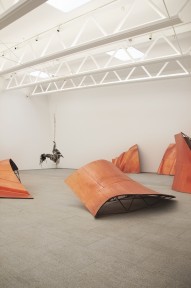
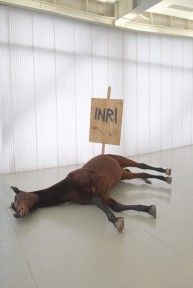
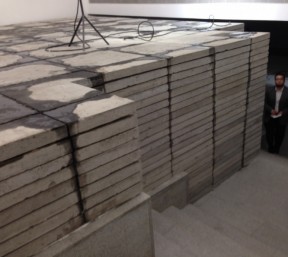
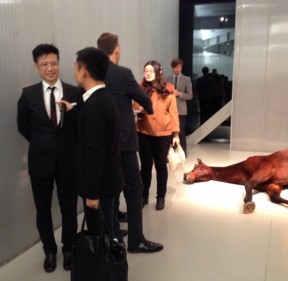
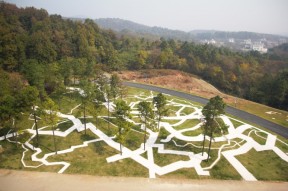
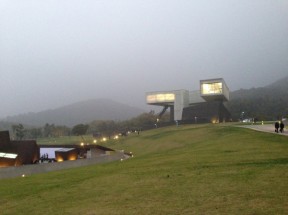
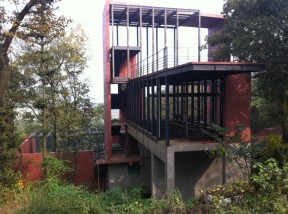
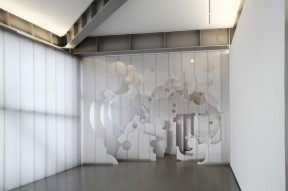
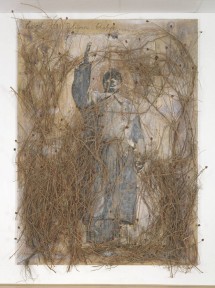
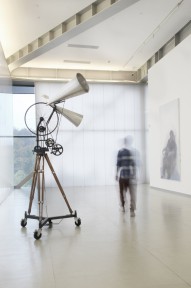


 Back to Index
Back to Index